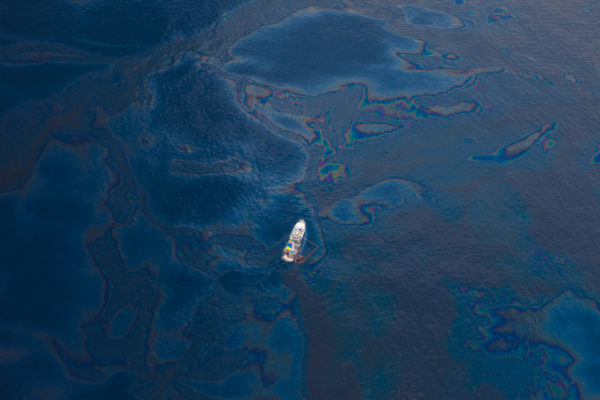An oil spill in the Gulf of Mexico last week may be the largest in the U.S. since the 2010 blowout at BP Plc’s Macondo well that sank the Deepwater Horizon rig and killed 11 people.
LLOG Exploration Co. reported 7,950 to 9,350 barrels of oil were released Oct. 11 to Oct. 12 from subsea infrastructure about 40 miles (64 kilometers) southeast of Venice, Louisiana, according to the company and the U.S. Bureau of Safety and Environmental Enforcement. That would make it the largest spill in more than seven years, BSEE data show, even though it’s a fraction of the millions of barrels ejected in the 2010 incident.
“Way offshore, the oil had time to dissipate before it could cause lots of damage,” Edward Overton, emeritus professor in the Environmental Sciences Department at Louisiana State University, said by telephone. “I’m sure there’s some impact associated with this spill out in the deep water, but I don’t think there was enough for the oil to sink.”
The LLOG spill was triggered by a fracture in a flowline jumper located on the sea floor, Rick Fowler, the company’s vice president for deepwater projects, said in an email Tuesday. That’s a short pipeline used to connect a well to nearby subsea structures. Multiple barriers placed on either side of the fracture stopped the release, but the the flowline jumper hadn’t yet been repaired, he said.
The subsea system affected by the fracture was shut in, reducing the oil flowing into the Delta House floating production facility and cutting its output to around 57,000 barrels of oil equivalent a day from more than 90,000 before the spill, Fowler said. Other systems connected to Delta House weren’t affected. LLOG hasn’t yet begun planning to restore output.
Government Investigation
BSEE, the federal agency which regulates offshore energy and mineral extraction, started a five-member panel investigation into the cause of the spill Monday, according to an online statement. The members, including inspectors, engineers and accident investigators, will issue their findings and make recommendations.
“This panel investigation is a critical step in ensuring BSEE determines the cause, or causes, of the incident and develops recommendations to prevent similar events from occurring in the future,” Lars Herbst, BSEE’s Gulf of Mexico region director, said in the statement.
The Delta House platform, floating in 4,500 feet of water, came online in April 2015 with peak capacity of 100,000 barrels a day of oil and 240 million cubic feet a day of natural gas. Its oil output enters the Heavy Louisiana Sweet crude pool. HLS’s premium to benchmark West Texas Intermediate crude widened 10 cents to $5.50 a barrel, according to data compiled by Bloomberg at 3:27 p.m. New York time. It has strengthened 40 cents since Oct. 12.
The 2010 blowout and explosion at the Deepwater Horizon ultradeep-sea drilling rig off the coast of Louisiana left 11 workers dead and set off the worst offshore oil spill in U.S. history. BSEE, an agency of the Interior Department, was established in the wake of the incident as part of reforms designed to separate federal regulatory responsibilities from lease sales and revenue generation.
“Deepwater Horizon was a wakeup call to the industry, because of the magnitude of the cost to BP,” Overton said. “That sends a strong message — don’t do this.”
Source: Bloomberg
Women of Green is TURNING UP THE VOLUME of the feminine voice on the planet in order to create the world we know is possible.
